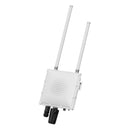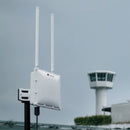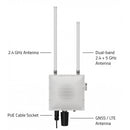Dronetag Scout is a PoE-powered, IP67 Remote ID receiver that tracks any compliant drone up to 15 miles with optional directional antennas. Chain multiple units for city-wide coverage, stream real-time telemetry to your system or Dronetag Cloud, and secure sensitive airspace—passively, without RF emissions.
A high-performance, PoE-powered Remote ID receiver engineered for airports, critical-infrastructure sites, and city-wide security networks. Dronetag Scout captures every Broadcast/Direct Remote ID message from any compliant drone—then delivers real-time telemetry to your command centre or cloud dashboard for decisive airspace control.
Up to 15 Miles / 25 km Detection
Dual 2.4 GHz receivers paired with high-gain antennas track drones at 10 km / 6 mi using the included omnis—and up to 25 km / 15 mi with optional directional antennas, meeting FAA, EASA, and MLIT standards for long-range situational awareness.
Scalable City-Wide Coverage
Interconnect multiple Scouts over Ethernet or LTE to blanket entire municipalities, critical corridors, or airport approach paths with a unified drone-detection grid.
Four Configurable Operation Modes
Sensor Mode
Standalone receiver streams raw Remote ID data (MQTT/JSON) to on-prem systems—ideal for low-overhead integrations.
Sensor Mode +
Adds manufacturer + model recognition, device-management tools, and premium support while keeping all data inside your own infrastructure.
Cloud Mode
Pushes detections directly to Dronetag Cloud for live web/mobile visualization and auto firmware updates—no backend development required.
On-Premise Mode
Keeps data on a local server for high-security sites; operators view the feed via the Dronetag App with zero internet exposure.

Modular Antenna Options
The baseline kit ships with two omnis (2.4 GHz and dual-band 2.4/5 GHz). Upgrade to one-to-four 90° directional antennas for noise-rejection in dense RF environments and reliable long-range coverage.
4G/LTE Modem Upgrade
Internal hardware add-on enables cellular backhaul when Ethernet isn’t practical. (SIM card required—Dronetag SIMs available on request.)

Rugged, All-Weather Construction
The IP67/NEMA-6 enclosure shrugs off rain, dust, and extreme temperatures from -4 °F to 122 °F (-20 °C to 50 °C), with passive cooling, integrated heating, and optional lightning protection.
Effortless Installation & PoE Power
Mount to a pole or wall, run a single PoE line for both power and data, and you’re operational in minutes—no RF emissions, no interference.
Cross-Platform Monitoring & APIs
View live drone tracks and historical logs in the Dronetag App (Web, iOS, Android) or pull data into third-party C-UAS/UTM platforms via REST API. Geofencing alerts keep teams informed 24/7.
Applications

Public-safety agencies, airport authorities, power plants, prisons, event-security teams, wildlife-protection units, urban-planning departments, and corporate security can all rely on Scout for continuous, compliant airspace monitoring.
A high-performance, PoE-powered Remote ID receiver engineered for airports, critical-infrastructure sites, and city-wide security networks. Dronetag Scout captures every Broadcast/Direct Remote ID message from any compliant drone—then delivers real-time telemetry to your command centre or cloud dashboard for decisive airspace control.
Up to 15 Miles / 25 km Detection
Dual 2.4 GHz receivers paired with high-gain antennas track drones at 10 km / 6 mi using the included omnis—and up to 25 km / 15 mi with optional directional antennas, meeting FAA, EASA, and MLIT standards for long-range situational awareness.
Scalable City-Wide Coverage
Interconnect multiple Scouts over Ethernet or LTE to blanket entire municipalities, critical corridors, or airport approach paths with a unified drone-detection grid.
Four Configurable Operation Modes
Sensor Mode
Standalone receiver streams raw Remote ID data (MQTT/JSON) to on-prem systems—ideal for low-overhead integrations.
Sensor Mode +
Adds manufacturer + model recognition, device-management tools, and premium support while keeping all data inside your own infrastructure.
Cloud Mode
Pushes detections directly to Dronetag Cloud for live web/mobile visualization and auto firmware updates—no backend development required.
On-Premise Mode
Keeps data on a local server for high-security sites; operators view the feed via the Dronetag App with zero internet exposure.

Modular Antenna Options
The baseline kit ships with two omnis (2.4 GHz and dual-band 2.4/5 GHz). Upgrade to one-to-four 90° directional antennas for noise-rejection in dense RF environments and reliable long-range coverage.
4G/LTE Modem Upgrade
Internal hardware add-on enables cellular backhaul when Ethernet isn’t practical. (SIM card required—Dronetag SIMs available on request.)

Rugged, All-Weather Construction
The IP67/NEMA-6 enclosure shrugs off rain, dust, and extreme temperatures from -4 °F to 122 °F (-20 °C to 50 °C), with passive cooling, integrated heating, and optional lightning protection.
Effortless Installation & PoE Power
Mount to a pole or wall, run a single PoE line for both power and data, and you’re operational in minutes—no RF emissions, no interference.
Cross-Platform Monitoring & APIs
View live drone tracks and historical logs in the Dronetag App (Web, iOS, Android) or pull data into third-party C-UAS/UTM platforms via REST API. Geofencing alerts keep teams informed 24/7.
Applications

Public-safety agencies, airport authorities, power plants, prisons, event-security teams, wildlife-protection units, urban-planning departments, and corporate security can all rely on Scout for continuous, compliant airspace monitoring.
Dronetag Scout Specifications
| Remote ID type | Broadcast / Direct Remote ID receiver |
| Supported frequencies | 2.4 GHz; 5.8 GHz (optional) |
| Message protocols | Bluetooth 4 & 5; Wi-Fi Beacon & NAN |
| Remote ID standards | ASTM F3411-22A; EN 4709-002 |
| Power / connectivity | PoE (802.3af); optional internal 4G/LTE modem |
| Max current draw | 6 W typical (10 W max) |
| Mounting options | Pole mount; wall mount |
| IP rating | IP67 / NEMA-6 |
| Operating temperature | -4 °F to 122 °F (-20 °C to 50 °C) |
| Dimensions | 8.7 × 8.7 × 4.1 in (220 × 220 × 104 mm) without antennas |
| Weight | 4.8 lb (2.2 kg) without antennas |
Baseline Configuration
(1) Dronetag Scout
(1) Omnidirectional 2.4 + 5 GHz Dual-Band Antenna
(1) Omnidirectional 2.4 GHz Antenna
(1) PoE Injector
(1) Power Cable for PoE (EU Plug, 220 V)
(1) Mast Holder Kit (mast adapter + hardware)
(1) Sealing Tape
Optional Upgrades
(1) LTE + GNSS Antenna (requires 4G/LTE Modem)
(1) 4G/LTE Modem Hardware Upgrade (SIM not included)
Directional Antenna Kit (1–4 × 90° antennas)
Introducing Dronetag Scout – Scalable Drone Detection
What kinds of drones can Scout detect?
Any aircraft or module that complies with FAA, EASA, or MLIT Broadcast/Direct Remote ID standards—regardless of brand—thanks to dual Bluetooth & Wi-Fi receivers. [oai_citation:6‡help.dronetag.com](https://help.dronetag.com/dronetag-scout/?utm_source=chatgpt.com)
How far does Scout reliably detect drones?
Up to 6 mi / 10 km with the included omnis and 15 mi / 25 km with optional directional antennas, line-of-sight.
Does Scout emit any RF signals or interfere with other systems?
No—Scout is a passive receiver and never transmits, so it introduces zero interference to surrounding equipment.
What power and network options are available?
The unit runs on standard PoE (802.3 af) for one-cable power + data. An internal 4G/LTE modem upgrade adds cellular backhaul when Ethernet isn’t feasible.
Can I integrate Scout with third-party C-UAS or UTM platforms?
Yes—Sensor and Sensor+ modes output raw JSON/MQTT feeds, while Cloud Mode exposes REST APIs for seamless integration.
Is the device weatherproof?
Absolutely. The IP67 enclosure handles dust, rain, sunlight, and temperature extremes from -4 °F to 122 °F.
How do I access the management interface?
Scout hosts an HTTPS dashboard on port 443 of its local IP, where you can preview detections, configure settings, and apply firmware updates.
Customer Reviews
Payment & Security
Your payment information is processed securely. We do not store credit card details nor have access to your credit card information.










